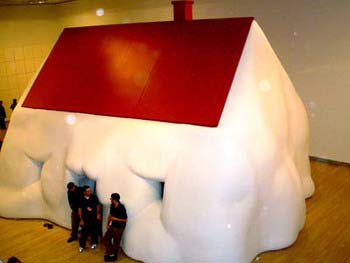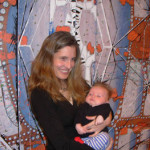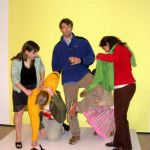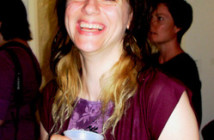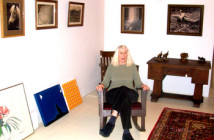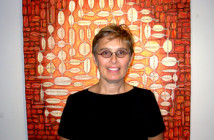For Austrian artists of the generation of Erwin Wurm, born in 1954, the challenge has been to get out from under the formidable gravitas of the strum und drang of the earlier Vienna Actionists of the 1960s. While he shares an interest in actions, or what is known in America as “performance art,” there is a very different lightness of touch. While he takes on intense social and political issues, including responses to post 9/ 11, a typical reaction is to laugh out loud at many of the images surveying the production of the last ten years, in the artist’s first, museum level, traveling exhibition “I Love My Time, I Don’t Like My Time” organized by Rene de Guzman of the Yerba Buena Center for the Arts. The exhibition opened last night at the Rose Art Museum of Brandeis University, as a part of the four day, Leonard Bernstein Festival of the Arts, and will remain on view through July 30. In the museum’s lower galleries Raphaela Platow has curated the first museum level exhibition of paintings of the Boston based artist, Sarah Walker, the 2005 recipient of the annual Rappaport Prize, awarded by the DeCordova Museum.
The centerpiece of the current installation is Wurm’s recent “Fat House.” It dominates the vast space of the Lois Foster Gallery. This is a sequel to the “Fat Car” which the artist presented in a survey of Austrian Artists presented by Mass MoCA in 2002. Then, as now, the artist has induced the curators, formerly Laura Heon, and currently, Platow, to squeeze into fat suits and pose for his camera. He must be a rather charming and charismatic guy to convince these slender and attractive young women to bloat up for him so dramatically. The images, a part of the “Grow” series, started with self portraits “Me/ Me Fat” in 1993. Previously, in 1991, he convinced his friend Fabio, to wear several sweaters one over the other, and, in 1992, to be photographed, much bulked up, in “Fabio Getting Dressed” wearing his entire wardrobe simultaneously.
Articles of clothing, with and without a human presence, have been a part of the artist’s work for some time. An early series of sculptures created by configurations of clothing were first show in the States at Stux Gallery, 1992 in New York, in cooperation with Vienna’s Krinzinger Gallery. These works were intriguing and, after a hiatus, the artist began to crop up again in museum shows mostly as photographs from the popular “One-Minute Sculptures,” a series of absurd actions with objects, through which the artist is most widely known. In an extension of that concept, during the Rose exhibition, visitors are invited to use items of clothing and ordinary objects, following the artist’s instructions, to create a series of living sculptures or tableaux vivant. There are Polaroid cameras available in the museum to document these spontaneous events.
Much of the exhibition on two levels comprises a series of large format photographs documenting his ephemeral actions. The series represented, in addition to the “Fat House” sculpture, and a model for the “Fat Car,” include “59 Positions,” 1992, “How to Be Politically Incorrect,” 2002-2003, “One-Minute Sculptures,” 1997 to the present, and “Instructions for Idleness,” 2001. Mostly these images are hilarious. But they can convey rather dark humor. Several photographs entail couples in which one of the participants is “Looking for a Bomb.” There can be a bit of groping involved. It is a humorous but absurd take on the all too common fact of life, the suicide bomber. But the threatening device, instead of being cleverly and dangerously concealed, bulges out all too obviously. One man reaches into the open fly of another. In an image of two men in the street, before a row of cars, one is probing into the mouth of the other. Or, in a restaurant setting, with two women dining, a man is diving head first down one woman’s sweater seemingly searching for an explosive device. The woman in question appears to be oblivious to the intrusion of her privacy.
In the over the top “How to Be Politically Incorrect” series a woman in a living room is casually peeing on the rug while we observe the legs of a man on the couch observing this transgression. A woman is looking at us sheepishly as she spits into the soup of her fellow woman diner. We are constantly amazed at how simple, clever and witty are his absurd situations and inventions. Overall, it makes for a delightful experience. Be sure to share this exhibition with a friend who “doesn’t like contemporary art.” They will surely change their mind. Wurm is a master of mischief and serious fun.
The space devoted to recent paintings by Sarah Walker makes a nice counterpoint to the light touch of Wurm. She makes stunningly intense, and complex, layered abstract paintings. Each work is uniquely different but they are united by a sense of exploring cosmology, quantum mechanics, string theory and all kinds of nifty, ersatz science and philosophy. Quite simply, they are stunning and beautifully crafted. Discussing the work Platow states that “She uses diagrams, patterns, topographical images and images scientists use to depict the visual state of the mind, or the internet. She layers them to create interwoven images of different types of reality-space, sprawl, the movement of information. It’s something we’re all concerned with.”
In addition to presenting all new paintings for the Rose exhibition, Walker will open a new show, in May, at the Bernard Toale Gallery in Boston. While on sabbatical this year from Clark University, in Worcester, the 42-year-old artist also found time to give birth, on March 2, to Walker Forest Ginzel, her first born. It’s been a busy year for the artist.
Links:
Rose Art Museum, Brandeis University
"Erwin Wurm: I Love My Time, I Don't Like My Time" & "Sarah Walker: Paintings" are on view April 27 – July 30, 2006 at The Rose Art Museum, Brandeis University.
All images are courtesy of the author.

